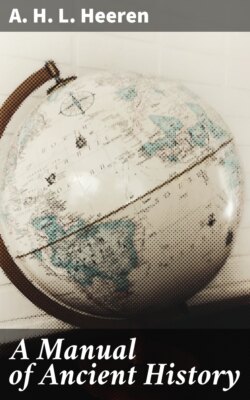Читать книгу A Manual of Ancient History - A. H. L. Heeren - Страница 33
Geographical Outline.
ОглавлениеBoundaries of Greece:
Greece is bounded on the north by the Cambunian mountains, which separate it from Macedonia; on the south and east by the Ægæan, on the west by the Ionian sea. its dimensions: Greatest length from south to north = 220 geog. miles, greatest breadth from west to east, = 140 geog. miles. Superficial contents, = 29,600 square miles.—Principal rivers: rivers: the Peneus, which discharges its waters into the Ægæan, and the Achelous, which flows into the Ionian sea. Advantages in respect to fertility, resulting from the mildness of the climate, physical advantages. between 37—40° N. lat.; from the number of small streams; from the qualities and variety of the soil, in which this country has been so much more blessed by nature than any other of similar extent, that every branch of cultivation may be prosecuted equally and in conjunction.—Advantages in reference to navigation and commerce: situated in the vicinity of the three quarters of the world, on three sides washed by the sea, and by reason of its irregular, indented coast, abounding with commodious ports and havens.
Divisions.
It may be divided into Northern Greece, from the north boundary to the chain of Œta and Pindus, between the Ambracian gulf west, and the Maliac east. Central Greece, or Hellas, down to the isthmus of Corinth: and the southern peninsula, or Peloponnesus.
Northern Greece.
Northern Greece comprises two countries; Thessaly east, Epirus west.
Thessaly.
1. Thessaly, the largest and one of the most fruitful of the Grecian countries. Length from north to south 60 geog. miles; breadth from west to east 64 geog. miles. Rivers: the Peneus, Apidanus, and several smaller streams. Mountains: Olympus, residence of the fabulous gods, and Ossa in the north; the chain of Œta, Othrys, and Pindus in the south. Division into five provinces: 1. Estiæotis; cities: Gomphi, Azorus: 2. Pelasgiotis; cities: Larissa, Gonni, the vale of Tempe: 3. Thessaliotis; cities: Pharsalus, etc. 4. Phthiotis; cities: Pheræ, etc. 5. The foreland of Magnesia, with a city of the same name. Other territories, such as Perrhæbia, etc. for instance, derived their names from the non-Greek races who inhabited them.
Epirus.
2. Epirus. Next to Thessaly, the largest, although one of the least cultivated countries of Greece: 48—60 geog. miles long, and the same in breadth. Divisions: Molossis; city, Ambracia: Thesprotia; city, Buthrotum; in the interior, Dodona.
Central Greece.
Central Greece, or Hellas, comprises nine countries.
Attica.
1. Attica, a foreland, extending towards the south-east, and gradually diminishing. Length, 60 geog. miles; greatest breadth, 24 geog. miles. Rivers: Ilissus, Cephissus. Mountains: Hymettus, Pentelicus, and the headland of Sunium. City: Athens, with the harbours Piræus, Phalereus, and Munychius; in the other parts no towns, but hamlets, δήμοι, such as Marathon, Eleusis, Decelea, etc.
Megaris.
2. Megaris, close to the isthmus of Corinth. The smallest of the Grecian countries; 16 geog. miles long, and from 4—8 broad. City, Megara.
Bœotia.
3. Bœotia, a mountainous and marshy country, 52 geog. miles long, and from 28—32 broad. Rivers: Asopus, Ismenus, and several smaller streams. Mountains: Helicon, Cythæron, etc. Lake: Copais.—Bœotia was, of all the Grecian countries, that which contained the greatest number of cities, each having its own separate territory. Among these, the first in importance, and frequently mistress of the rest, was Thebes on the Ismenus. The others, Platææ, Tanagra, Thespiæ, Chæronea, Lebadea, Leuctra, and Orchomenus, are all celebrated in Grecian history.
Phocis.
4. Phocis, smaller than Attica; 48 geog. miles long, from 4—20 broad. River: Cephissus. Mountain: Parnassus. Cities: Delphi, on Parnassus, with the celebrated oracle of Apollo. Crissa, with the harbour of Cirrha, and up the country Elatea. The other cities are insignificant.
Locris 1st and 2nd.
5, 6. The two countries called Locris. The eastern on the Euripus, territory of the Locri Opuntii and Epicnemidii is the lesser of the two; being but little larger than Megaris. City: Opus; pass, Thermopylæ. The western Locris on the Corinthian gulf, station of the Locri Ozolæ, is from 20—24 geog. miles long, and from 16—20 broad. Cities: Naupactus on the sea, Amphissa up the country.
